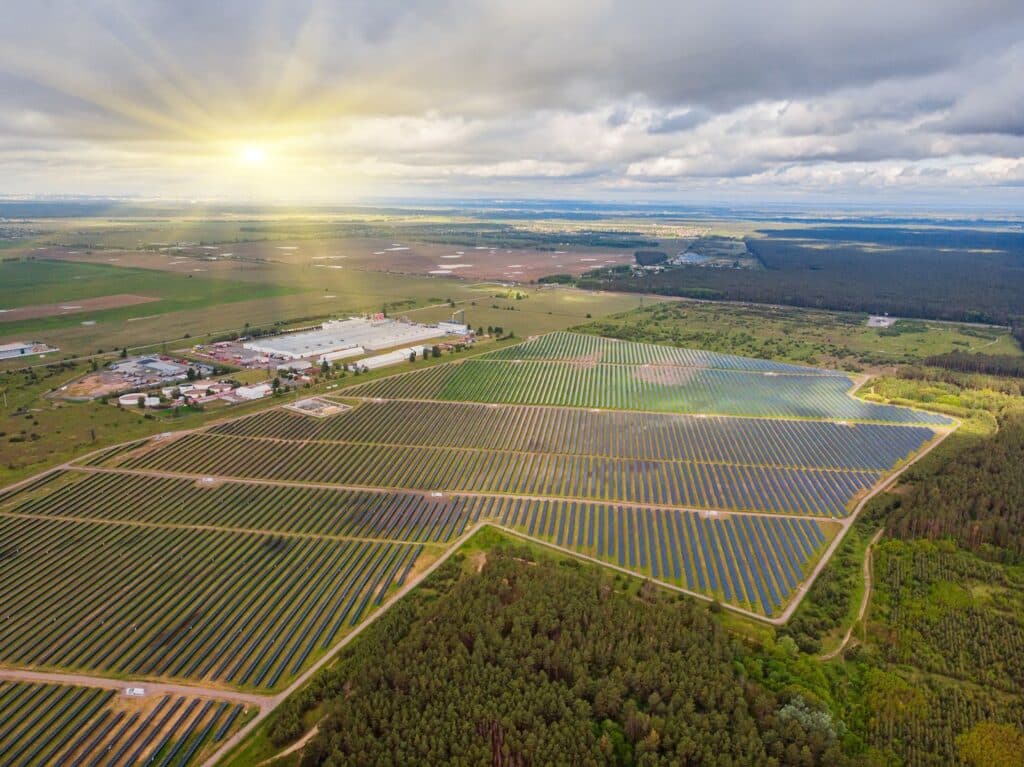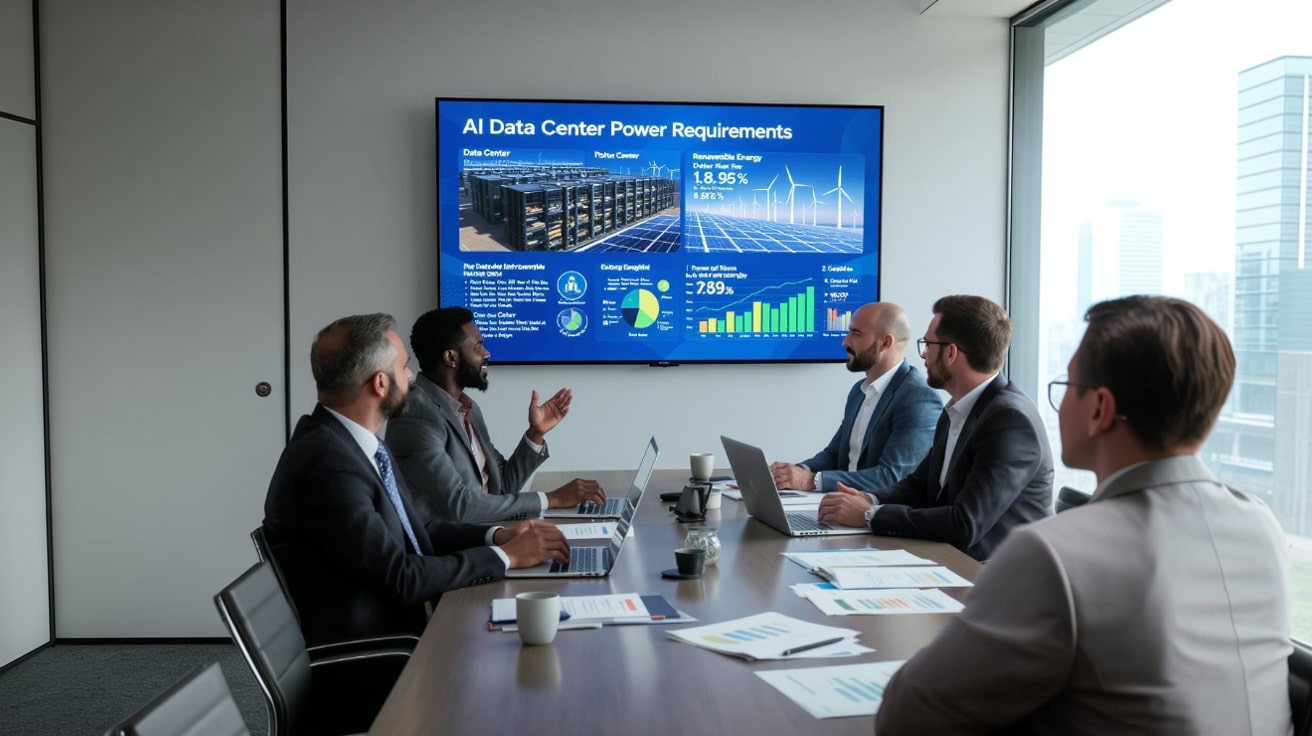SUMMARY: AI data centers will consume 165% more power by 2030, but renewable energy solutions including solar + battery storage, energy campuses, and hybrid systems can meet this demand sustainably. Success requires strategic site selection, advanced cooling technologies, and integrated energy infrastructure that combines generation, storage, and computing on single campuses.
A single ChatGPT query consumes nearly 10 times more electricity than a Google search. Goldman Sachs Research confirms that global data center power demand will surge 165% by 2030, driven by artificial intelligence workloads. 174 Power Global specializes in developing renewable energy infrastructure specifically designed to meet this exponential growth.
The critical question: can renewable energy infrastructure scale fast enough to meet AI’s unprecedented power appetite without compromising grid stability or climate goals?
What Makes AI Data Centers Consume 165% More Power Than Traditional Facilities?
Power requirements for ai data centers fundamentally differ from conventional computing infrastructure. Where traditional servers draw 6-12 kW per rack, AI-optimized facilities demand 50-100 kW per rack, with cutting-edge configurations exceeding 200 kW.
The exponential increase stems from specialized hardware requirements. Graphics processing units (GPUs) consume up to 700 watts each – nearly eight times a typical flat-screen television’s consumption. When thousands of these processors operate simultaneously for AI model training, cumulative energy demand becomes astronomical.
MIT research demonstrates that running a single large AI model consumes equivalent energy to 120 U.S. homes annually. Model training amplifies this challenge because it’s non-linear and unpredictable, requiring infrastructure capable of sustained peak loads without performance degradation.

The International Energy Agency projects AI will drive the most significant data center electricity demand growth, with AI-optimized facilities quadrupling power consumption by 2030. This represents a fundamental shift from cyclical computing workloads to constant, high-intensity operations demanding entirely new energy procurement approaches.
How Are Grid Constraints Limiting AI Data Center Expansion?
Data center energy consumption trends reveal severe infrastructure bottlenecks across major markets. Northern Virginia, hosting the world’s largest data center concentration, faces 85% power demand growth over 15 years, with data center demand quadrupling.
Critical infrastructure delays now exceed five years in multiple regions:
- West London data centers wait until 2030 for grid connections
- Southern Sweden implements queuing systems for electrical capacity
- Many U.S. markets face 3-7 year delays for new generation capacity
Supply chain disruptions compound infrastructure challenges. Lead times for transformers and switchgear extend 12-18 months beyond historical norms. McKinsey analysis reveals the fundamental tension: data center construction requires 18-24 months while power infrastructure development demands 3-7 years for generation and up to 10 years for transmission.
These constraints force companies to completely rethink expansion strategies, prioritizing energy-first development approaches over traditional location-based decisions.
Infrastructure Bottlenecks: The Cooling and Reliability Challenge
Power requirements for ai data centers extend far beyond raw electricity consumption. The intense heat generated by high-density GPU clusters demands revolutionary cooling approaches that themselves consume substantial energy.
Traditional air cooling systems struggle with AI workloads. Cooling typically accounts for 30-40% of total data center power consumption, but this percentage rises significantly in AI facilities where dense racks generate unprecedented heat loads. Advanced liquid cooling systems can reduce cooling energy consumption by up to 30% compared to air cooling, but widespread adoption remains limited.
Some facilities are experimenting with immersion cooling, where servers are literally bathed in specialized coolants. This approach can reduce cooling electricity requirements by up to 95% while improving computing performance, but it requires significant infrastructure modifications and operational expertise.
The reliability imperative adds another layer of complexity. AI training sessions often require synchronization across thousands of GPUs, where any interruption can result in substantial computational and financial losses. This drives demand for redundant power systems, high-capacity uninterruptible power supplies, and backup generation that can handle multi-megawatt loads instantaneously.
These technical challenges are forcing data center operators to reconsider fundamental assumptions about infrastructure design, power procurement, and operational resilience.
Which Renewable Energy Solutions Can Reliably Power 24/7 AI Operations?
Solar + battery storage systems now provide viable primary power for AI facilities requiring constant uptime. Large-scale solar installations generate electricity during peak daylight hours, charging high-capacity batteries that discharge during evening demand peaks or grid outages.
DC-coupled battery systems optimize energy discharge patterns and minimize conversion losses. These systems respond to load fluctuations within milliseconds, making them ideal for AI workloads experiencing rapid power demand changes.
Wind energy provides complementary generation profiles, producing power during nighttime hours when solar output diminishes. Hybrid renewable systems combining solar, wind, and storage achieve near-constant clean power availability, addressing intermittency concerns that historically limited renewable adoption.
Green hydrogen represents breakthrough technology for long-term energy storage and backup power. Excess renewable energy produces hydrogen through electrolysis, which stores indefinitely and converts back to electricity when needed. This eliminates diesel backup generators while providing carbon-free emergency power.
Corporate Leadership Driving Renewable Adoption
Hyperscale operators lead renewable energy procurement through massive long-term commitments. Amazon consumed 30.9 TWh in 2021 with 85% from renewable sources, targeting 100% renewables by 2025. Major technology companies have become some of the largest corporate renewable energy buyers globally, supporting gigawatts of new clean energy development.
These commitments extend beyond environmental goals to include economic benefits. Long-term Power Purchase Agreements provide cost predictability and hedge against fossil fuel price volatility. Virtual PPAs enable companies to support renewable development financially while meeting sustainability targets even when physical renewable delivery isn’t feasible.

How Do Energy Campuses Solve AI Data Center Power Needs?
Energy campuses represent integrated development approaches that co-locate data centers with dedicated renewable resources, creating self-contained ecosystems optimizing performance and sustainability.
These facilities provide superior control over power costs, emissions, and reliability while reducing dependence on constrained utility grids. Energy campuses enable future expansion planning, allowing organizations to scale computing capacity alongside energy generation.
Microgrids combine on-site generation, storage, and intelligent control systems into self-contained energy networks. These systems operate independently during grid outages while optimizing renewable utilization and load management. Advanced energy management systems enable real-time optimization based on renewable availability, compute demand, and grid conditions.
Geographic optimization prioritizes regions with abundant renewable resources, available land, and supportive regulatory environments over traditional metropolitan proximity. Iceland, the Pacific Northwest, and Texas attract significant investment due to renewable energy potential and favorable operating conditions.
Workload Shifting and Smart Distribution
Cloud providers implement workload shifting strategies routing AI tasks to locations where renewable energy is most abundant. This approach maximizes clean energy utilization while maintaining performance standards.
Digital infrastructure solutions increasingly emphasize strategic site selection based on renewable energy potential, grid capacity, and regulatory support rather than solely considering metropolitan proximity.
7 Proven Strategies for Sustainable AI Data Center Scaling
1. Deploy Hybrid Renewable Systems for Maximum AI Workload Reliability
Combine solar, wind, and battery storage to create resilient energy systems providing 24/7 clean power availability. Hybrid systems achieve 80-90% renewable energy utilization while maintaining grid stability and operational reliability required for AI operations.
2. Implement Advanced Cooling Technologies to Reduce Energy Consumption
Adopt liquid cooling, immersion cooling, or waste heat recovery systems reducing cooling energy consumption by 30-95%. These technologies enable higher computing densities while improving overall performance and efficiency for GPU-intensive AI workloads.
3. Optimize Geographic Site Selection for Renewable Energy Access
Choose locations based on renewable energy potential, grid capacity, and regulatory support rather than metropolitan proximity. Strategic site selection reduces energy costs by 40-60% while improving renewable energy access and development timelines.
4. Establish Energy Campus Partnerships for Integrated Development
Partner with specialized developers integrating renewable generation, energy storage, and digital infrastructure from project inception. This approach reduces development timelines while minimizing operational complexity and capital requirements.
5. Deploy Grid-Scale Battery Systems for Enhanced Operations
Install large-scale battery systems storing excess renewable energy while providing grid services during peak demand periods. These systems generate additional revenue streams while improving energy security and reliability for AI operations.
6. Integrate Green Hydrogen for Long-Term Energy Storage
Develop hydrogen production and storage for long-term energy storage and backup power generation. Green hydrogen eliminates diesel dependency while providing unlimited storage duration and carbon-free emergency power capabilities.
7. Leverage AI-Driven Energy Management for Optimization
Use artificial intelligence to optimize energy consumption, predict demand patterns, and coordinate renewable generation with computing workloads. AI energy management systems provide significant efficiency improvements while reducing operational costs and carbon emissions.
What Emerging Technologies Will Power AI Data Centers by 2030?
Small modular nuclear reactors (SMRs) attract significant investment as potential sources of carbon-free baseload power. Companies like Microsoft explore nuclear partnerships providing dedicated clean power for their largest facilities, recognizing nuclear’s ability to provide constant power output regardless of weather conditions.
Enhanced geothermal systems experience renewed interest, particularly technologies that provide consistent power output regardless of weather conditions. Advanced geothermal technologies could unlock gigawatts of clean baseload capacity in regions previously unsuitable for renewable development.

Policy Support Accelerating Renewable Adoption
Production tax credits, investment tax credits, and regulatory frameworks encourage clean energy development through substantial financial incentives. The Inflation Reduction Act provides significant incentives for renewable energy projects, particularly those supporting domestic manufacturing and critical infrastructure.
However, the recent federal tax legislation signed into law on July 4, 2025, presents new challenges by eliminating key renewable energy tax credits and incentives, creating urgency for private sector solutions and alternative financing mechanisms. This policy shift makes energy campus development and direct renewable procurement even more critical for organizations seeking cost-effective, sustainable power solutions for AI infrastructure expansion.
Grid modernization initiatives address transmission bottlenecks and interconnection delays historically slowing renewable deployment. Federal and state investments in transmission infrastructure, smart grid technologies, and energy storage create new opportunities for large-scale renewable integration.
International coordination becomes increasingly important as data centers evolve into global infrastructure. Cross-border renewable energy trading, standardized sustainability metrics, and coordinated technology development emerge as critical success factors for global AI infrastructure deployment.
Ready to Power AI Infrastructure with Renewable Energy Solutions?
The convergence of artificial intelligence and renewable energy represents both an unprecedented challenge and a transformative opportunity. AI’s exponential power demands strain existing infrastructure while simultaneously accelerating innovation in clean energy technologies and integrated development models.
Success requires strategic partnerships, advanced technology integration, and long-term planning that aligns digital growth with environmental responsibility. Organizations that embrace energy-first development approaches position themselves for competitive advantages in both performance and sustainability.
For organizations ready to build AI infrastructure powered by renewable energy, 174 Power Global delivers comprehensive energy campus solutions that integrate clean generation, strategic site selection, and scalable power delivery specifically designed for the AI era.
Frequently Asked Questions
How much more power do AI data centers require compared to traditional computing facilities? AI data centers typically consume 2-4 times more power per square foot than traditional facilities, with individual racks drawing 50-100 kW compared to 6-12 kW for conventional servers. GPU-intensive AI training can push power densities to 200+ kW per rack.
Can renewable energy sources reliably power 24/7 AI data center operations? Yes, properly designed renewable systems with battery storage and hybrid configurations provide 99.9%+ reliability while meeting constant power demands. Modern renewable plus storage systems use intelligent energy management and grid interconnection to ensure uninterrupted operations.
What are the biggest barriers preventing renewable energy adoption for AI data centers? Grid interconnection delays (3-5 years), high upfront capital costs, and technical integration complexity remain primary barriers. However, energy campus development approaches, policy incentives, and technology advances are rapidly addressing these challenges.
How long does renewable energy infrastructure development take for AI data centers? Integrated energy campus projects require 24-36 months from site selection to operation, compared to 3-7 years for traditional utility-scale development. This acceleration results from streamlined permitting, co-located development approaches, and specialized energy-first development strategies.What role will energy storage play in future AI data center power strategies? Energy storage becomes essential for managing renewable intermittency, providing backup power, and optimizing energy costs. Large-scale battery systems increasingly replace diesel generators while enabling higher renewable energy utilization and grid service revenue generation.



